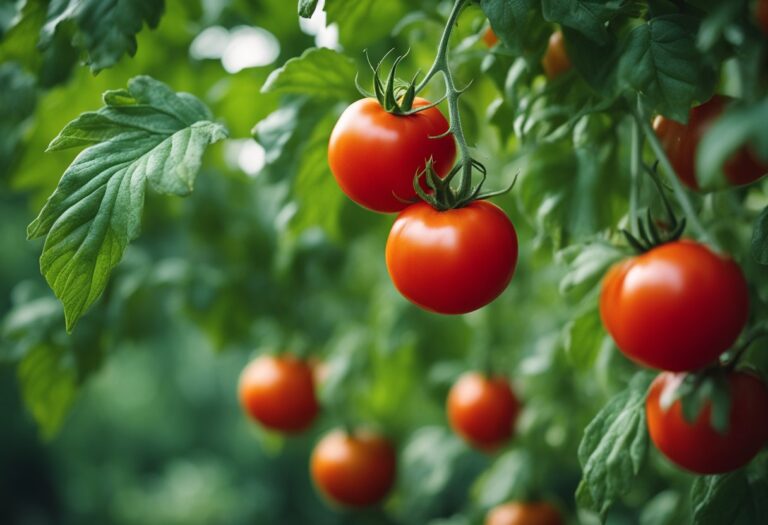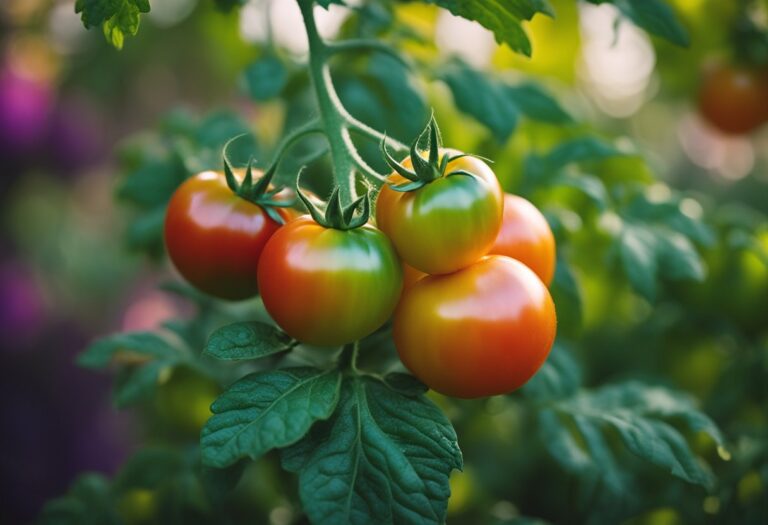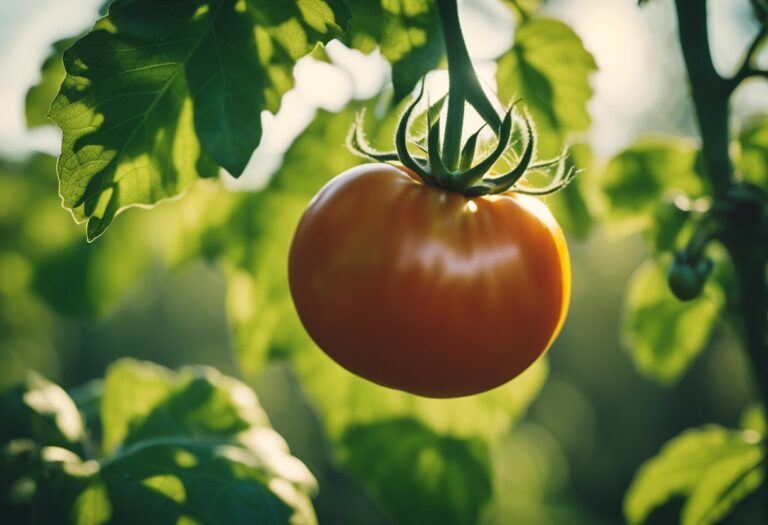Homemade Tomato Cages: How to Make Them Yourself
If you’re growing tomatoes in your garden, you’ll need a way to support them as they grow taller and heavier. One popular solution is to use tomato cages. While you can purchase pre-made cages from garden centers, making your own homemade tomato cages can be a fun and rewarding DIY project.

There are many benefits to making your own tomato cages. For one, you can customize the size and shape of the cages to fit your specific garden and tomato variety. You can also choose materials that are more affordable or sustainable than the options available at the store. Plus, making your own cages can be a fun way to get creative and add a personal touch to your garden.
Key Takeaways
- Homemade tomato cages offer customization and affordability.
- Materials such as wood, wire, and PVC can be used to make DIY tomato cages.
- Building and maintaining your own tomato cages can be a fun and rewarding DIY project.
Benefits of Homemade Tomato Cages

When it comes to growing tomatoes, using homemade tomato cages can provide many benefits. Here are a few reasons why you should consider making your own tomato cages:
Cost-Effectiveness
One of the main benefits of homemade tomato cages is their cost-effectiveness. Instead of buying expensive cages from a store, you can create your own using materials that are readily available and affordable. For example, you can use PVC pipes, wooden stakes, or even chicken wire to make your own tomato cages. By making your own cages, you can save money and still provide your tomatoes with the support they need to grow.
Customization
Another advantage of homemade tomato cages is the ability to customize them to fit your specific needs. You can adjust the size, shape, and height of your cages to accommodate different types of tomato plants. For instance, if you have a variety of tomato plants with different growth habits, you can create cages that are tailored to each plant’s needs. By customizing your tomato cages, you can ensure that your plants have the support they need to thrive.
Durability
Homemade tomato cages are also known for their durability. Unlike store-bought cages that may be made from flimsy materials, homemade cages can be constructed from sturdy materials that can withstand the elements. For example, using galvanized steel or treated wood can help ensure that your cages last for many growing seasons. Additionally, if a homemade cage does break or become damaged, it is often easier and more cost-effective to repair it than to replace it entirely.
In summary, homemade tomato cages offer many benefits, including cost-effectiveness, customization, and durability. By making your own cages, you can save money, tailor your cages to your specific needs, and provide your plants with the support they need to grow and thrive.
Materials Needed for DIY Tomato Cages

When it comes to making your own tomato cages, there are a few materials you’ll need to get started. In this section, we’ll go over some of the most common materials used for DIY tomato cages, including wood and wire mesh, as well as some of the tools and supplies you’ll need to complete the project.
Choosing the Right Wood
If you’re planning to make your tomato cages out of wood, there are a few things to keep in mind. First, you’ll want to choose a type of wood that is rot-resistant, such as cedar or redwood. These types of wood are more durable and will last longer than other types of wood.
Second, you’ll want to choose a wood that is the right size and thickness for your tomato plants. For most tomato plants, a 1×1 or 2×2 piece of wood will work well. You’ll also want to make sure the wood is straight and free of knots, as these can weaken the structure of the cage.
Wire Mesh Options
Wire mesh is another popular material for DIY tomato cages. There are several different types of wire mesh to choose from, including galvanized steel, concrete reinforcing mesh, and hardware cloth.
Galvanized steel mesh is a good option if you’re looking for something that is durable and rust-resistant. Concrete reinforcing mesh is a heavier-duty option that is often used for larger tomato plants. Hardware cloth is a finer mesh that is good for smaller tomato plants.
When choosing wire mesh for your tomato cages, make sure to choose a size that is appropriate for your plants. You’ll also want to make sure the mesh is sturdy enough to support the weight of the plants as they grow.
Tools and Supplies
In addition to the materials listed above, you’ll also need a few tools and supplies to complete your DIY tomato cages. These may include:
- Saw or wire cutters (depending on the material you’re using)
- Drill
- Screws or wire ties
- Measuring tape
- Pencil or marker
Make sure to gather all of the necessary tools and supplies before you begin your project. This will help ensure that the process goes smoothly and that you’re able to complete your tomato cages in a timely manner.
Building Your Tomato Cage
Measuring and Cutting
Before you start building your tomato cage, you need to measure the size of your tomato plants. You want to make sure that your cage is tall enough to support the plant as it grows. Measure the height of your tomato plant from the ground to the top of the plant, and add a few inches to that measurement to determine the height of your cage.
Next, you need to cut the materials for your tomato cage. If you’re using wood, cut four pieces of wood to the desired length. If you’re using PVC, cut the PVC pipes to the desired length. Make sure to cut the pieces evenly so that your tomato cage is symmetrical.
Assembling the Frame
Once you have all of your materials cut to size, it’s time to assemble the frame of your tomato cage. If you’re using wood, you can use screws or nails to attach the pieces together. If you’re using PVC, you can use PVC glue to attach the pipes together.
To assemble the frame, start by attaching two of the pieces together to form a right angle. Repeat this step with the remaining pieces until you have a square frame. Make sure that the corners are square and the frame is sturdy.
Attaching the Mesh
The final step in building your tomato cage is attaching the mesh to the frame. You can use chicken wire or remesh for the mesh. Cut the mesh to the desired size, leaving a few inches on each side to attach it to the frame.
To attach the mesh, start by securing one end of the mesh to the frame using staples or zip ties. Pull the mesh taut and secure the other end to the frame. Continue this process until the entire frame is covered in mesh.
Congratulations, you’ve successfully built your own homemade tomato cage! Your plants will now have the support they need to grow healthy and strong.
Installation and Planting
Positioning the Cage
To install your homemade tomato cage, choose a location in your garden with well-draining soil that receives at least six hours of sunlight per day. Position the cage over the tomato plant when it is still small, centering the plant within the cage as best you can. Follow recommended spacing for tomato plants, which is generally 24 to 36 inches between plants.
Securing the Cage
Once you have positioned the cage over the tomato plant, it’s important to secure it in place. Drive the legs of the cage at least a foot into the ground to provide stability. You can also add a wooden or PVC stake for additional support. Use zip ties or twine to attach the stake to the cage, making sure not to tie it too tightly around the stem of the tomato plant.
Planting Tomatoes
Before planting your tomatoes, test your soil pH and amend it if necessary. Aim for a pH of 6.0-6.8 and incorporate organic matter such as compost to enrich the soil and improve texture. Loosen the soil by tilling the ground to aerate and allow room for roots. When planting your tomatoes, dig a hole deep enough to cover the stem up to the first set of leaves. Fill the hole with soil and gently pat it down around the plant. Water thoroughly to help the plant establish itself.
By following these simple steps, you can install your homemade tomato cage and plant your tomatoes with confidence. With proper care and maintenance, your tomato plants will thrive and produce a bountiful harvest.
Maintenance and Care
Watering and Fertilizing
Tomatoes require consistent watering and fertilizing to produce a bountiful harvest. Water your tomato plants deeply and regularly, ensuring that the soil remains consistently moist but not waterlogged. You can also consider using a drip irrigation system to provide a steady supply of moisture to the roots.
Fertilize your tomato plants with a balanced fertilizer, following the manufacturer’s instructions for application rates. You can also use organic fertilizers such as compost, bone meal, or fish emulsion to provide the necessary nutrients.
Pruning and Training
Pruning and training your tomato plants is essential for maintaining healthy growth and maximizing fruit production. Remove any suckers that emerge from the base of the plant or between the main stem and branches. This will help to direct the plant’s energy towards producing fruit rather than foliage.
Train your tomato plants to grow upwards by tying them to the tomato cage with twine or plant ties. This will help to prevent the plants from sprawling on the ground and reduce the risk of disease.
Winter Storage
Once the growing season is over, it’s important to properly store your tomato cages to ensure their longevity. Clean the cages thoroughly with soap and water to remove any dirt or debris, then allow them to dry completely.
Store the cages in a dry, cool place such as a garage or shed. You can also consider disassembling the cages and storing them flat to save space.
By following these simple maintenance and care tips, you can ensure that your homemade tomato cages provide sturdy support for your tomato plants year after year.
Frequently Asked Questions
How can I create a tomato cage using PVC pipes?
To make a tomato cage using PVC pipes, you will need PVC pipes, connectors, and a PVC cutter. Cut the PVC pipes into the desired length and connect them using the connectors to create a square or triangular shape. Make sure to secure the joints using PVC glue. Place the cage over the tomato plant and secure it to the ground using stakes or by filling the bottom with soil.
What’s the best way to make tomato cages from wire at home?
One of the best ways to make tomato cages from wire at home is to use a wire mesh. Cut the mesh into the desired length and width using wire cutters. Roll the mesh into a cylinder and bend the open ends over the mesh to secure the cage closed. Push the cage, cut ends down, into the soil around your tomato plant.
Can you provide plans for constructing homemade tomato cages?
Yes, there are many plans available online for constructing homemade tomato cages. Some popular options include using PVC pipes, wire mesh, or wooden stakes. You can also get creative and use recycled materials such as old fencing, bed frames, or even tree branches.
How do you build a sturdy wooden tomato cage?
To build a sturdy wooden tomato cage, you will need wooden stakes, a saw, and a drill. Cut the wooden stakes into the desired length and drill holes into each end. Connect the stakes using screws or bolts to create a square or triangular shape. Place the cage over the tomato plant and secure it to the ground using stakes or by filling the bottom with soil.
What are some creative ways to use sticks to support tomato plants?
Using sticks to support tomato plants is a cost-effective and creative way to provide support. You can use bamboo stakes, tree branches, or even wooden skewers. Simply insert the sticks into the ground around the tomato plant and tie the plant to the stick using twine or plant ties.
Are there any cost-effective alternatives to traditional tomato cages?
Yes, there are many cost-effective alternatives to traditional tomato cages. Some options include using stakes, trellises, or even tomato spirals made from wire. You can also get creative and use recycled materials such as old fencing, bed frames, or even tree branches.




